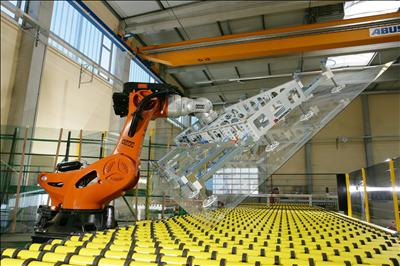5 Factors to Consider before Buying a Robot Gripper

Posted on May 07, 2014 in Robot Grippers
4 min read time
When you are designing your robotic cell there are a lot of details that you need to consider. You want to maximally increase the level of security and make your cell as efficient as possible. It might be hard to think of all of these details in a single design, therefore we are providing you with 5 tips to look at before buying a robot gripper.
1. Application
It may sound a little simple, but looking into the required applications is the best way to begin a design. What are you looking to do? What do you need to handle? There are a lot of robotic end effectors out there and you don’t want to buy and be stuck with a robot gripper that doesn't fit your application. Begin by determining the geometry of what you need to handle. Is it a cylinder that needs to be handled by the inside or is it a box that needs to be grabbed carefully? Once the shape is determined, you may also want to consider the finish or the texture of it. For example, does the gripper need to be soft to prevent scratches? The rigidity of the part should also be considered. Objects, such as windshields, are hard but easy to break into pieces. This is one of the reasons why you should use suction cups instead of a grasping mechanical gripper to move those kind of objects around the working area.
Another aspect of your applications that needs to be considered is if there will be a tool changer system involved, perhaps because of the different dimensions of the parts involved. You should also think about what type of robot will receive the gripper. For example, if collaborative robots are used and need to be placed at different working stations for different applications, you will need a flexible robot gripper to be adaptable to different handling situations.

2. Payload-Grip Force
This factor not only affects the robot gripper, but the robotic arm itself. In fact, the payload is another important piece of data to consider with caution. Having a robotic cell carrying an object whose weight is close to the maximum payload of the robot will result in a slowdown of the robot cell. If the application needs to be fast and smooth, you may want to look for a robot/gripper that can handle a little more than your actual object. Talking about grip force, one of the factors that you should consider is having enough grip force so that the object cannot be dropped in the grasping position. On the other hand, you don’t want an excessive grip force to crush the object itself. To get more details on the payload vs grip force you should consult this past article or see how a gripper can handle fragile parts.
3. Precision
A lot of robotic applications require speed, but most of them still need to achieve motions with precision and accuracy. Since these factors are hard to determine, due to the numerous applications out there, you may want to get a gripper that is very repeatable. In fact, the position of the gripper will depend on the industrial robot and if the repeatability of the gripper is good, most of your handling motions should be accurate enough for your application. Compliance should also be considered when talking about precision.

4. Speed
This factor encompasses a lot of different concepts that have been previously mentioned. In fact, when looking to optimize your process, you may want to enhance the acceleration and speed, but you cannot do this without having a secure grip. For example, if a certain part is thin and slick, such as sheet metal, and the coefficient of friction between the sheet and your gripper is too low, you must also consider the inertia of a maximum speed which will likely be reached. When talking about the speed of the whole cycle, another factor to consider is the speed of the gripper itself. You have to make sure that the clamping time of your gripper fits well with your cycle time. For example, magnetic grippers do an excellent job when talking about gripping force because the action is performed almost instantaneously. On the other hand grippers that require air pressure or hydraulic pressure can be slower due to different losses in the system.
5. Cost
At the end of the day it all comes down to pricing… You might find that if the best gripper for your application is too expensive, it is not economical to use it. This is why you should know the price of the gripper and its different options before going too far into your integration plan. Other aspects of the price include the different accessories and options such as wrists and cables. These kinds of accessories have a certain price and need to be added to the total.
To get further information on the different end-effectors you should take a look at the following e-book on how to choose the right end-effector. It will give you a general description of the functionality of the end-effectors, as well as a description of their strengths and weaknesses.


.jpg)





Leave a comment